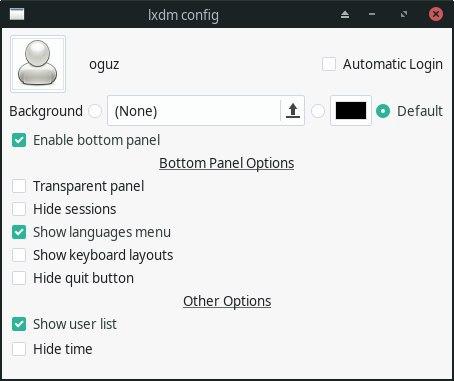Translations:LXDM Configuration/2/en
Views
Actions
Namespaces
Variants
Tools
LXDM can still be easily customized to suit personal taste and preference, including the ability to enable auto-login, change the background image, remove the language menu, and disable the user list. |}
Option 1: Using the Customisation Tool
| The LXDM Configuration application may be found under System in the XFCE and Cinnamon Menus. Openbox users will also find it under System if using the Openbox AppFinder application. Alternatively, searching for lxdm in Synapse will yield the correct result.
To launch from the commandline use user $ sudo lxdm-config
|
Option 2: Manually Editing the Configuration File
To undertake any or all of these tasks, it will be necessary to first open the LXDM configuration file (lxdm.conf) using the terminal. The syntax of the command to open the LXDM configuration file is:
For example, if you wish to edit the file within the terminal using nano (a standard terminal-based text editor) then enter:
Otherwise - if you have installed the full version of Manjaro (i.e. not the NET-Edition) - you may find it easier to use the pre-installed gedit text editor instead. This will open the configuration file up as a document, making it easier to read and edit. To use gedit instead, enter:
Enabling Auto-Login
It is possible to bypass the login screen completely and go straight into your chosen desktop environment upon booting up Manjaro. To do so, two basic steps are required: first, it will be necessary to set the user account to be automatically logged into, and second, it will then be necessary to state the particular desktop environment to be started.
Step 1: Set the User
The first step is to set your personal account to be automatically logged in. This is undertaken in the following section, located at the top of the LXDM configuration file:
[base] ## uncomment and set autologin username to enable autologin # autologin=dgod
As an example, LXDM has been configured below to enable a personal user account named 'carl' to be logged in automatically:
[base] ## uncomment and set autologin username to enable autologin autologin=carl
Ensure that there are no spaces between the autologin= command and the name of your personal user account. Once complete, the second and final step of setting the default desktop environment to be automatically started must be undertaken.
Step 2: Set the Desktop Environment
It is necessary to ensure what desktop environment is to be booted into, and/or if having installed multiple desktop environments. This is set in the following section, located near the top of the configuration file:
## default session or desktop used when no systemwide config session=/usr/bin/startxfce4
In this example, the default desktop environment has already been set to XFCE as this was the Manjaro edition installed. If you have installed a different edition (e.g. Gnome/Cinnamon or KDE), then the session listed will be different. Where there is not a hash ('#') at the beginning of session= (meaning this command won't be ignored), and the desired desktop environment has been listed, then you may save your changes and close the configuration file by:
- nano: Press CTRL and 'x' to exit, 'y' to save, and <enter> to finish, or
- gedit: Select the 'save' option and then close the window.
Otherwise, to set the desired desktop environment:
- If present, remove the hash ('#') at the beginning of session=
- Remove the existing desktop environment listed (or any other text such as 'lxdm') from session=/usr/bin/[text to be removed], and
- Add the command to start your chosen / installed desktop envrionment at the end of session=/usr/bin/.
Examples for different desktop environments has been listed below:
- To start XFCE:
## default session or desktop used when no systemwide config session=/usr/bin/startxfce4
- To start KDE:
## default session or desktop used when no systemwide config session=/usr/bin/startplasma-x11
- To start Gnome:
## default session or desktop used when no systemwide config session=/usr/bin/gnome-session
- To start Cinnamon:
## default session or desktop used when no systemwide config session=/usr/bin/gnome-session-cinnamon
- To start Razor-QT:
## default session or desktop used when no systemwide config session=/usr/bin/razor-session
- To start Openbox:
## default session or desktop used when no systemwide config session=/usr/bin/openbox-session
- To start LXDE:
## default session or desktop used when no systemwide config session=/usr/bin/lxsession
Once your amendments have been completed, you can save your changes and close the configuration file by:
- nano: Press CTRL and 'x' to exit, 'y' to save, and <enter> to finish, or
- gedit: Select the 'save' option and then close the window.
Reboot your system for the changes to take effect.
